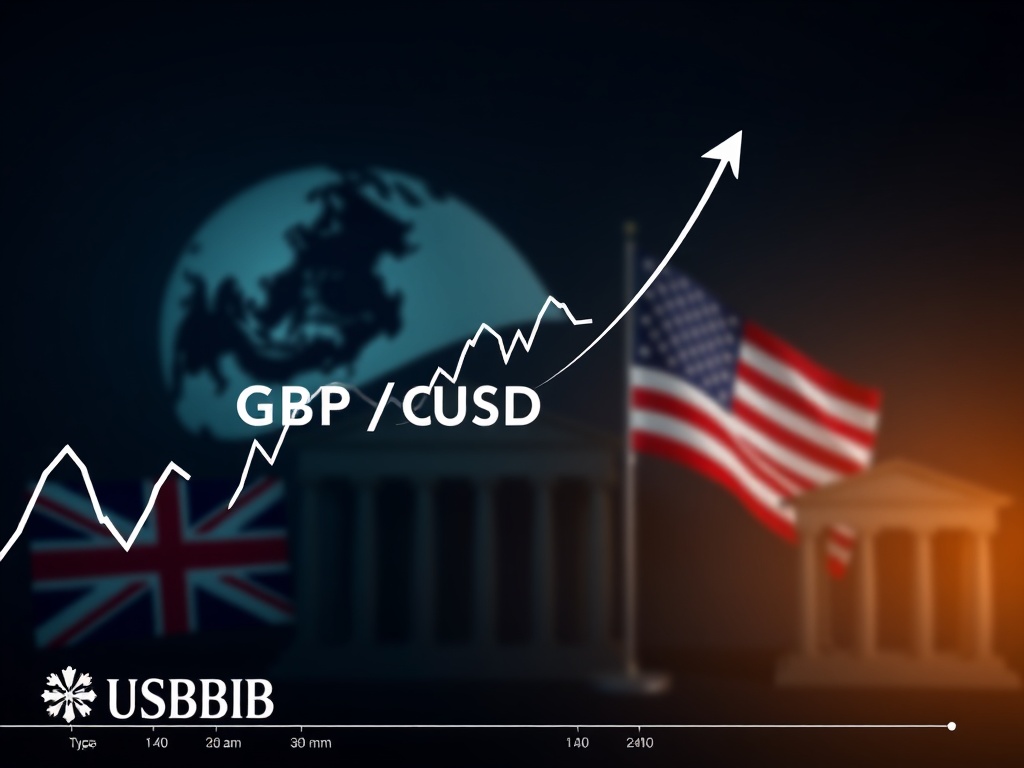BitcoinWorld

GBP/USD Forecast: Unlocking the Strategic 1.40 Target by UBS
For anyone keeping an eye on the broader financial landscape, especially those immersed in the dynamic world of cryptocurrencies, understanding traditional market movements is crucial. While digital assets often grab headlines, shifts in major currency pairs like GBP/USD can signal broader economic trends, influencing everything from global trade to investor sentiment. Recently, a significant forecast from banking giant UBS has caught the attention of market participants: they anticipate the GBP/USD forecast to reach 1.40 by mid-2026. This isn’t just a number; it’s a potential indicator of shifting economic tides between the UK and the US, and understanding its implications can offer valuable insights for diversified portfolio strategies.
Understanding the GBP/USD Forecast: UBS’s Bullish Stance
The GBP/USD currency pair, often referred to as ‘Cable,’ represents the exchange rate between the British Pound (GBP) and the US Dollar (USD). It’s one of the most actively traded pairs globally, reflecting the economic health and monetary policy divergence between the United Kingdom and the United States. UBS, a leading global financial services company, has put forth a notably optimistic GBP/USD forecast, projecting a rise to 1.40 within the next two and a half years. This target, if realized, would mark a substantial appreciation for the Pound against the Dollar from its current levels, signaling a potential reversal or significant strengthening trend.
What’s Fueling the UBS Prediction? Key Drivers Behind the Pound’s Potential Ascent
UBS’s bullish outlook isn’t pulled from thin air; it’s grounded in a meticulous analysis of various macroeconomic factors. Several key drivers are expected to contribute to the Pound’s potential strengthening against the Dollar.
- Monetary Policy Divergence: A primary factor is the anticipated shift in monetary policy between the Bank of England (BoE) and the Federal Reserve (Fed). While both central banks have been aggressive in raising interest rates to combat inflation, market expectations suggest the BoE might maintain a relatively tighter policy for longer, or at least be slower to cut rates compared to the Fed. Higher interest rates typically attract foreign investment, increasing demand for the local currency.
- Inflation Trends: The trajectory of inflation in both economies plays a crucial role. If UK inflation proves more persistent, compelling the BoE to keep rates elevated, while US inflation moderates more rapidly, allowing the Fed to ease policy, this divergence would naturally support the Pound.
- Economic Resilience: The relative economic performance of the UK versus the US is another consideration. Signs of greater resilience or unexpected growth in the UK economy, especially as it navigates post-Brexit challenges, could bolster investor confidence in the Pound. Conversely, any signs of a significant slowdown or recession in the US could weaken the Dollar.
- Global Risk Appetite: The US Dollar often acts as a safe-haven currency during times of global uncertainty. If global economic conditions stabilize or improve, leading to increased risk appetite among investors, the demand for safe-haven assets like the Dollar might decrease, allowing riskier currencies like the Pound to gain ground.
To illustrate the potential divergence in economic indicators that could underpin this UBS prediction, consider the following hypothetical scenario:
| Economic Indicator | UK Outlook (UBS Perspective) | US Outlook (UBS Perspective) |
|---|---|---|
| Interest Rates (BoE vs. Fed) | Higher for Longer / Slower Cuts | Earlier / More Aggressive Cuts |
| Inflation Trend | Persistent, Gradual Decline | Moderating Faster |
| GDP Growth | Steady, Gradual Recovery | Potential Soft Landing / Mild Slowdown |
| Labour Market | Tight, Wage Growth Pressure | Cooling, but Resilient |
Navigating the Forex Market: Opportunities and Challenges for Traders
A significant move in GBP/USD, as projected by UBS, presents both opportunities and challenges for participants in the Forex market.
Opportunities:
- Long Positions: Traders who believe in the UBS forecast could take long positions on GBP/USD, aiming to profit from the Pound’s appreciation.
- Carry Trade Potential: If the interest rate differential between the UK and the US widens in favor of the Pound, carry trades (borrowing in a low-interest currency and investing in a high-interest currency) could become more attractive.
- Hedging Strategies: Businesses with exposure to GBP or USD could use this forecast to refine their hedging strategies, potentially reducing currency risk on international transactions.
Challenges:
- Uncertainty and Volatility: The path to 1.40 is unlikely to be linear. Geopolitical events, unexpected economic data, or shifts in central bank rhetoric can introduce significant volatility, leading to sharp price swings.
- Policy Reversals: Central bank policies are data-dependent. A sudden resurgence of inflation in the US or an unexpected economic downturn in the UK could force policy reversals, invalidating current forecasts.
- External Shocks: Global events, such as new conflicts, commodity price spikes, or financial crises, can override domestic economic fundamentals and impact currency valuations unpredictably.
Understanding these dynamics is crucial for anyone looking to engage with the Forex market effectively, whether through direct trading or managing currency exposure in broader investments.
What Does This Mean for the Pound to Dollar Exchange Rate? Broader Implications
The potential ascent of the Pound to Dollar exchange rate to 1.40 has far-reaching implications beyond just currency traders.
- For UK Exporters: A stronger Pound makes UK exports more expensive for international buyers, potentially reducing demand. Conversely, it makes imported goods cheaper, which could help dampen domestic inflation.
- For US Tourists in the UK: A higher GBP/USD rate means US tourists get fewer Pounds for their Dollars, making holidays in the UK more expensive. For UK tourists in the US, their Pound would buy more Dollars, making US travel more affordable.
- For Investors with International Portfolios: UK-based investors holding US assets would see the value of those assets decrease in Pound terms as the Pound strengthens. Conversely, US-based investors holding UK assets would see their investments appreciate in Dollar terms.
- For Corporate Earnings: Multinational corporations with significant operations or revenues in either currency will see their reported earnings affected by currency fluctuations. For example, a US company earning in GBP would see its Dollar-denominated earnings increase with a stronger Pound.
This movement isn’t just about numbers on a screen; it directly impacts the purchasing power of consumers, the profitability of businesses, and the returns on international investments. The shift in the Pound to Dollar ratio reflects fundamental economic shifts that resonate across various sectors.
Crafting Your Strategy: Actionable Insights for the Currency Outlook
Given UBS’s intriguing currency outlook for GBP/USD, how can individuals and investors position themselves? While no forecast is guaranteed, prudent planning can help navigate potential market shifts.
- Monitor Key Economic Data: Keep a close eye on inflation reports, interest rate decisions, GDP figures, and employment data from both the UK and the US. These releases are often the primary catalysts for short-term currency movements.
- Diversify Your Portfolio: Relying solely on a single currency pair or asset class can be risky. Diversifying across different currencies, asset classes (including traditional equities, bonds, and even cryptocurrencies), and geographies can help mitigate exposure to adverse currency movements.
- Consider Hedging Strategies: If you have significant exposure to either GBP or USD through international business or investments, explore hedging options like forward contracts or currency options to lock in exchange rates and protect against unfavorable swings.
- Understand Risk Management: For those directly trading Forex, always employ robust risk management techniques, including setting stop-loss orders, managing position sizes, and never risking more capital than you can afford to lose. Volatility can be high, and even strong forecasts can be subject to unforeseen events.
- Consult Financial Professionals: For complex financial decisions or significant investments, seeking advice from a qualified financial advisor who specializes in currency markets or international investments can provide tailored guidance based on your specific financial situation and risk tolerance.
The journey to 1.40 for GBP/USD, if it materializes, will be influenced by a multitude of factors. Staying informed and adopting a strategic approach to your investments, considering this long-term currency outlook, is paramount.
In conclusion, UBS’s forecast of GBP/USD reaching 1.40 by mid-2026 presents a compelling narrative for the coming years. This optimistic outlook is underpinned by expectations of diverging monetary policies, varying inflation trajectories, and relative economic resilience between the UK and the US. While the path ahead will undoubtedly be marked by volatility and external factors, understanding the potential drivers and implications of such a significant move is vital for anyone engaged in the financial markets. Whether you’re a seasoned Forex trader, an international business, or an investor looking to diversify, keeping this GBP/USD forecast in perspective can inform more strategic decision-making and help navigate the evolving global economic landscape.
To learn more about the latest Forex market trends, explore our article on key developments shaping Pound to Dollar movements and interest rates liquidity.
This post GBP/USD Forecast: Unlocking the Strategic 1.40 Target by UBS first appeared on BitcoinWorld and is written by Editorial Team





